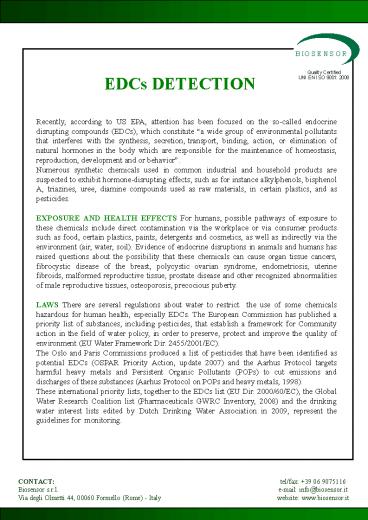Diapositiva 1 - PowerPoint PPT Presentation
1 / 2
Title:
Diapositiva 1
Description:
EDCs DETECTION Recently, according to US EPA, attention has been focused on the so-called endocrine disrupting compounds (EDCs), which constitute a wide group of ... – PowerPoint PPT presentation
Number of Views:1
Avg rating:3.0/5.0
Title: Diapositiva 1
1
EDCs DETECTION
Recently, according to US EPA, attention has been
focused on the so-called endocrine disrupting
compounds (EDCs), which constitute a wide group
of environmental pollutants that interferes with
the synthesis, secretion, transport, binding,
action, or elimination of natural hormones in the
body which are responsible for the maintenance of
homeostasis, reproduction, development and or
behavior. Numerous synthetic chemicals used in
common industrial and household products are
suspected to exhibit hormone-disrupting effects
such as for instance alkylphenols, bisphenol A,
triazines, uree, diamine compounds used as raw
materials, in certain plastics, and as
pesticides. EXPOSURE AND HEALTH EFFECTS For
humans, possible pathways of exposure to these
chemicals include direct contamination via the
workplace or via consumer products such as food,
certain plastics, paints, detergents and
cosmetics, as well as indirectly via the
environment (air, water, soil). Evidence of
endocrine disruptions in animals and humans has
raised questions about the possibility that these
chemicals can cause organ tissue cancers,
fibrocystic disease of the breast, polycystic
ovarian syndrome, endometriosis, uterine
fibroids, malformed reproductive tissue, prostate
disease and other recognized abnormalities of
male reproductive tissues, osteoporosis,
precocious puberty. LAWS There are several
regulations about water to restrict the use of
some chemicals hazardous for human health,
especially EDCs. The European Commission has
published a priority list of substances,
including pesticides, that establish a framework
for Community action in the field of water
policy, in order to preserve, protect and improve
the quality of environment (EU Water Framework
Dir. 2455/2001/EC). The Oslo and Paris
Commissions produced a list of pesticides that
have been identified as potential EDCs (OSPAR
Priority Action, update 2007) and the Aarhus
Protocol targets harmful heavy metals and
Persistent Organic Pollutants (POPs) to cut
emissions and discharges of these substances
(Aarhus Protocol on POPs and heavy metals, 1998).
These international priority lists, together to
the EDCs list (EU Dir. 2000/60/EC), the Global
Water Research Coalition list (Pharmaceuticals
GWRC Inventory, 2008) and the drinking water
interest lists edited by Dutch Drinking Water
Association in 2009, represent the guidelines for
monitoring.
CONTACT Biosensor s.r.l. Via degli Olmetti 44,
00060 Formello (Rome) - Italy
tel/fax 39 06 9075116 e-mail
info_at_biosensor.it website www.biosensor.it
2
INSTRUMENT
The OPTICBIO-MiniFluo 2 cells is a small portable
instrument to optically characterize the
fluorescence emission of biologic material. It
offers 2 measurement cells to conduct a
contemporary identical experiment on two
different samples or on one sample and a blank
reference.
TARGET ANALYTES compounds mentioned in the
priority lists (e.g. atrazine, chloridazon,
diuron, isoproturon, nicosulfuron,
simazine). SAMPLE waste water discharged by
domestic residences, industry and agriculture
drinking water, water extracts. METHODOLOGY
optical detection. The fluorescence emission is
measured as function of analytes concentration.
The biomediator is intrinsically fluorescent or
marked with a fluorescent probe.
EXAMPLES OF BIOMEDIATORS
Measurement Kit provided with reagents, buffer
solutions and biologic material for a fast
screening of the samples (see User Manual
Detection Kit). Various biomediators are supplied
depending on the analyte to be detected.
The OPTICBIO-MiniFluo 2 cells offers a lot of
advantages respect to the conventional analytical
techniques portability, low size and weight, no
pre-concentration treatments, sensitivity, fast
response time, low cost. This biosensor is a
versatile instrument and provides informations
for the pre-screening of a large number of
samples for further HPLC or GC-MS analysis.
CONTACT Biosensor s.r.l. Via degli Olmetti 44,
00060 Formello (Rome) - Italy
tel/fax 39 06 9075116 e-mail
info_at_biosensor.it website www.biosensor.it































